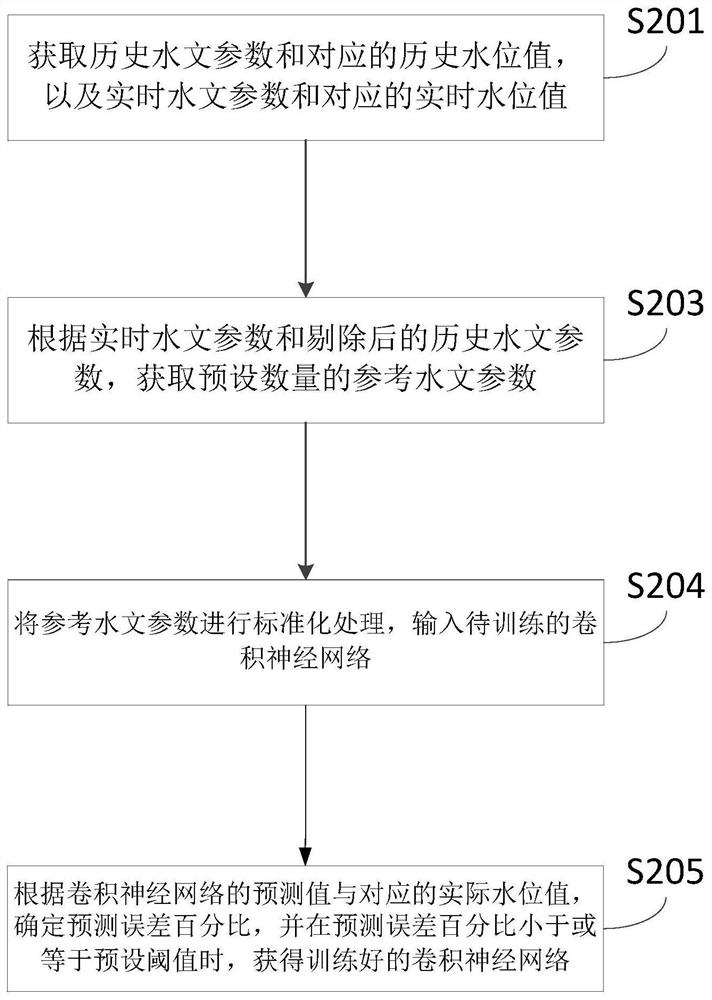Water level prediction method based on convolutional neural network
A convolutional neural network and prediction method technology, applied in neural learning methods, biological neural network models, prediction and other directions, can solve problems such as failure to consider, underfitting, and differentiation
- Summary
- Abstract
- Description
- Claims
- Application Information
AI Technical Summary
Problems solved by technology
Method used
Image
Examples
Embodiment 1
[0048] Such as figure 1 As shown, the present embodiment provides a water level prediction method based on a convolutional neural network, including:
[0049] S101 Acquiring the target hydrological parameters to be predicted, the target hydrological parameters include one or more of rising water level, upstream water level, downstream water level, discharge flow of upstream reservoir and interval precipitation;
[0050] S102 After standardizing the target hydrological parameters, input them into the trained convolutional neural network, wherein the convolutional neural network includes three layers of convolutional layers and two layers of fully connected layers connected in sequence, and the preset weight of the convolutional layer is greater than Preset weights for fully connected layers;
[0051] S103 predicts the water level value corresponding to the target hydrological parameter within a specified time period after the current time period according to the output of the ...
Embodiment 2
[0074] Such as figure 2 As shown, on the basis of Embodiment 1, in the water level prediction method based on the convolutional neural network in this embodiment, the convolutional neural network is trained based on an online elimination process including:
[0075] S201 Acquire historical hydrological parameters and corresponding historical water level values, as well as real-time hydrological parameters and corresponding real-time water level values;
[0076] S203 Obtain a preset number of reference hydrological parameters according to the real-time hydrological parameters and the historical hydrological parameters after elimination;
[0077] S204 standardizes the hydrological parameters and inputs them into the convolutional neural network to be trained;
[0078] S205 Determine the prediction error percentage according to the prediction value of the convolutional neural network and the corresponding actual water level value, and obtain a trained convolutional neural networ...
Embodiment 3
[0103] On the basis of Example 2, such as Figure 4 As shown, in a specific implementation, this embodiment will refer to the hydrological parameters for standardization processing, and before inputting the convolutional neural network to be trained, it also includes:
[0104] S202 Initialize the weights of the convolutional layer and the fully connected layer to obtain corresponding preset weights;
[0105] Among them, the weights of the convolutional layer are initialized according to the normal distribution random numbers with a mean value of 0 and a standard deviation of 1.
[0106] It should be noted that the convolutional neural network achieves better performance through continuous iterative updating of the weights, and the above iterative updating process is closely related to the weights of the network layer, and bad weights will still lead to gradients in the model training process. Problems such as disappearance and gradient explosion. This scheme initializes the ...
PUM
 Login to View More
Login to View More Abstract
Description
Claims
Application Information
 Login to View More
Login to View More - R&D
- Intellectual Property
- Life Sciences
- Materials
- Tech Scout
- Unparalleled Data Quality
- Higher Quality Content
- 60% Fewer Hallucinations
Browse by: Latest US Patents, China's latest patents, Technical Efficacy Thesaurus, Application Domain, Technology Topic, Popular Technical Reports.
© 2025 PatSnap. All rights reserved.Legal|Privacy policy|Modern Slavery Act Transparency Statement|Sitemap|About US| Contact US: help@patsnap.com



